The following article is a preview (and not a review) of the Ryobi P421 Angle Grinder as it has not been personally put to use, and is intended to be an info page with some description, photographs and technical specifications as provided by the manufacturer.
If you have arrived here from a search engine, kindly note that this article is linked from The Devon Buy Collection of Power Tools and Machineries. To open the main page in a new browser tab, click here.
Having bought the Bosch GWS 8-100 CE Variable Speed Angle Grinder a number of months back and used it on some tile renovation works, I thought having a cordless grinder would be the next best thing to own. And that’s how the Ryobi Angle Grinder P421 18V One+ came into my collection.
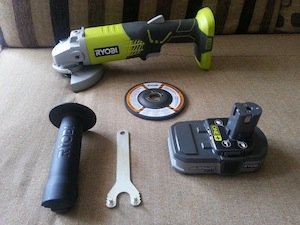
The Ryobi P421 is a cordless angle grinder that operates on 18V lithium-ion battery, and being already on the manufacturer’s One+ series of cordless power tools and owning the charger and several battery packs, buying the Ryobi P421 didn’t need much convincing. The ability to buy this tool bare (without charger and battery) also meant cost affordable ownership.
At the time of purchase, cordless angle grinders weren’t as common, as grinders require a lot of power and lower battery voltages at 10.8V and 12V were quite unlikely to be able to cater to this requirement. The Milwaukee M12 12-volt series certainly didn’t have it, although an 18-volt brushless motor M18 version is now available.
Just to sidetrack a little, I was on Milwaukee’s M12 series and own a number of their power tools in this series, but none on the M18. I was, however, already on the 18V One+ series by Ryobi, so buying the P421 just made a lot more sense, of course.
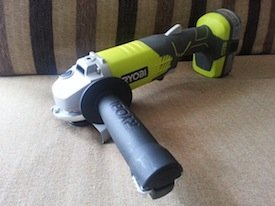 |
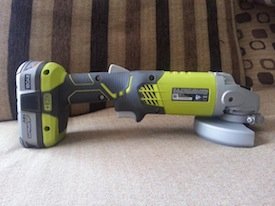 |
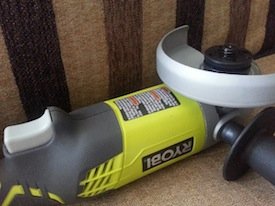 |
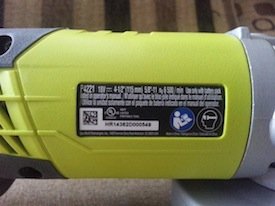 |
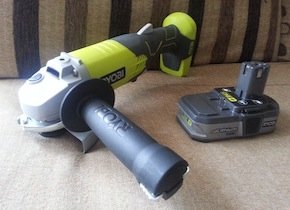
As mentioned, the Ryobi P421 runs on 18V and is suited for high power applications. It is cordless, so that means one would not be bogged down by cumbersome cables or extension cords, or the need to search for power source. Running on DC current also means safety against electrical hazards when working in wet areas, and the Ryobi P421 would do well in DIY work at bathrooms and wet garages. And speaking of garage, I foresee the Ryobi P421 Angle Grinder to be a very suitable tool for auto work at the place where my car is usually park – well-lit but without any power socket outlets.
Trigger and Lock-Off Switches
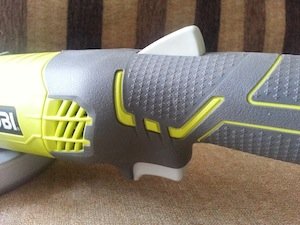
The angle grinder uses 4½-inch grinding wheel and delivers up to 6,500 revolutions per minute of grinding speed and precision. Operation begins by depressing the trigger switch at the usual spot on the underside of the angle grinder, but on the Ryobi P421, an additional lock-off switch on the opposite site at the top will need to be depressed first. This is a safety mechanism that prevents the accidental and unintended operation of the angle grinder.
While the lock-off switch is located at a convenient spot at the top of the handle and can be depressed without much thought when properly holding the angle grinder for work, I found that it did feel a little uncomfortable having this moving part in contact with the fleshy part of my palm. I have only run the angle grinder in short bursts, and I am not sure if extended use for long period grinding work would make it feel any more comfortable, or eventually getting used to that sensation. I can’t say for now, but it isn’t really a big deal. Personally, I would prefer to do without this additional switch as with most other angle grinders, but ultimately, safety is still a top priority.
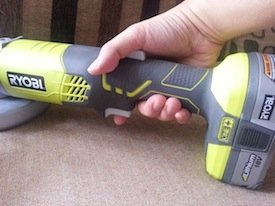 |
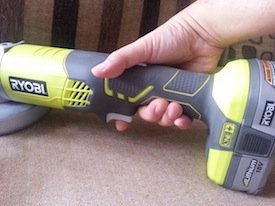 |
Auxiliary Side Handle
Like most other grinders in the market, the Ryobi P421 comes with an auxiliary side handle that allows for two-handed use. This side handle can be mounted at three different spots at the 3-, 9-, and 12-o’clock positions, for enhanced ergonomics and working ease.
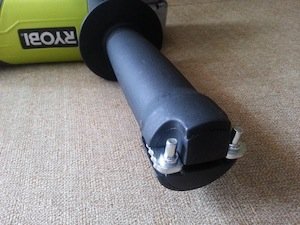
And one other thing I have to highlight, as I had done with all my previews and reviews of Ryobi One+ series of power tools, is the ingenuity of the manufacturer to keep ancillaries on the power tool itself. For the Ryobi P421, the wrench used to tighten the clamp nut on the spindle with every wheel change is stored within the side handle itself. This is really clever and makes it convenient for the tool user, without needing to reach out for the wrench kept elsewhere, and reduces the likelihood of this wrench ever going missing and being misplaced.
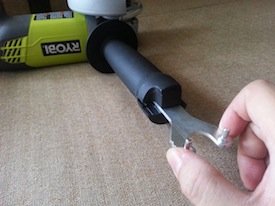 |
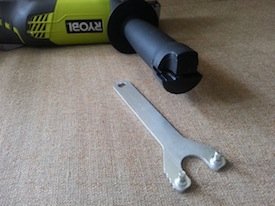 |
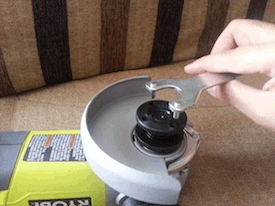 |
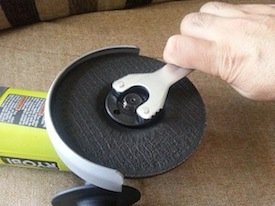 |
Tool-free Grind Wheel Guard
Again, like most angle grinders, the Ryobi P421 comes with a semi-circular grind wheel guard as standard. However, unlike most others, adjustment of this wheel guard position does not require any tool, and can be simply rotated through its multiple notched locked positions on the angle grinder. This makes shifting the guard on the fly to suit a variety of job conditions possible. Seems Ryobi give a lot of thought in making tool usage easier and convenient for the tool operator.
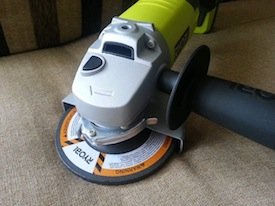 |
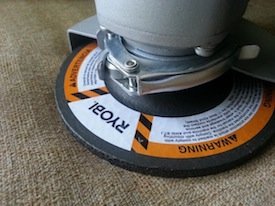 |
Manufacturer Specifications
| Specifications | Technical Data |
|---|---|
| Rotation speed | 6,500 revs/min (no load) |
| Saw blade | 4½-inch diameter |
| Weight | 2.2 kg (4.8 lbs) |
Conclusion
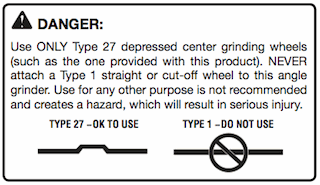
I have not had the pleasure of using the Ryobi P421 on an actual job, and hence this article remains as a preview (rather than a review) for now. All observations above were based on running the tools dry, without applying it on a work material. Grinding jobs are less common in my field of work, and I would love to put this angle grinder to the test the moment the opportunity presents itself. Of course, I could always go grind on some waste metal somewhere, but I think I will just wait for a more realistic use for it. When I do, I’ll post the updates here.
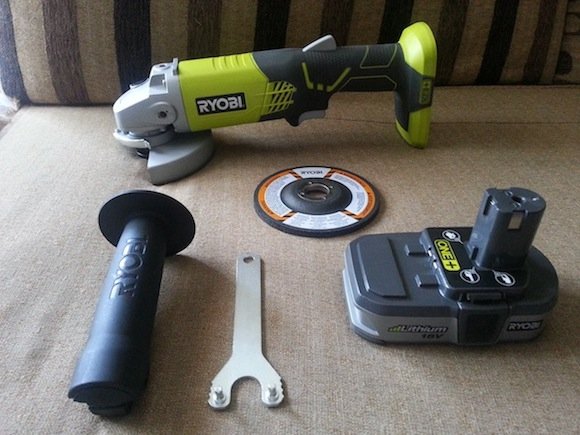
SEE ALSO:
- Ryobi P320 18V One+ AirStrike Brad Nailer
- Ryobi P506 18V One+ Circular Saw with Laser Guide
- Ryobi P514 18V One+ Reciprocating Saw
